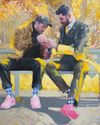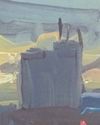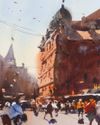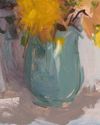
The main principle that distinguishes Old Masterworks from contemporary realism is the use of value and shadow to create an illusion of a three-dimensional form on a two-dimensional surface. The principle, which became known as chiaroscuro, an Italian term meaning “light-dark”, is actually surprisingly simple. When illuminated properly, form divides into two major masses of value: light and shadow. If you learn to replicate the exact shapes of both light and shadow and pay particular attention to the transitions between them, you will be able to capture a likeness and draw anything realistically. Since its introduction in the 15th century, this approach has been successfully practiced by many artists that we admire today.
HOW DO I LIGHT MY SUBJECT?
To achieve the beautiful soft transitions characteristic of the Old Masters’ works, illuminate your subject with natural light. Artificial lighting creates much stronger contrasts, harder edges, and often alters the color temperature. Always work with one light source and make sure you have clearly defined light and dark masses. (Two or more light sources will not only dilute the shadows but also weaken the structure of your drawing). Position your model near a large window or skylight. North light is best as it hardly changes throughout the day, but other windows will do as well as long as there is no direct sunlight.
WHAT IS THE ‘TROIS CRAYONS’ TECHNIQUE?
I was already working as a portrait painter when I first came across some Italian Renaissance drawings done in the so-called Trois crayons (or “three-color”) technique. These preparatory studies for a multi-figure oil painting were carefully rendered in black, red and white chalk on a beige-colored paper. I was struck by the lifelike effect that could be produced with such a limited palette.
Bu hikaye Artists & Illustrators dergisinin December 2019 sayısından alınmıştır.
Start your 7-day Magzter GOLD free trial to access thousands of curated premium stories, and 9,000+ magazines and newspapers.
Already a subscriber ? Giriş Yap
Bu hikaye Artists & Illustrators dergisinin December 2019 sayısından alınmıştır.
Start your 7-day Magzter GOLD free trial to access thousands of curated premium stories, and 9,000+ magazines and newspapers.
Already a subscriber? Giriş Yap

Still life IN 3 HOURS
Former BP Portrait Award runner-up FELICIA FORTE guides you through a simple, structured approach to painting alla prima that tackles dark, average and light colours in turn

Movement in composition
Through an analysis of three masterworks, landscape painter and noted author MITCHELL ALBALA shows how you can animate landscape composition with movement

Shane Berkery
The Irish-Japanese artist talks to REBECCA BRADBURY about the innovative concepts and original colour combinations he brings to his figurative oil paintings from his Dublin garden studio

The Working Artist
Something old, something new... Our columnist LAURA BOSWELL has expert advice for balancing fresh ideas with completing half-finished work

Washes AND GLAZES
Art Academy’s ROB PEPPER introduces an in-depth guide to incorporating various techniques into your next masterpiece. Artwork by STAN MILLER, CHRIS ROBINSON and MICHELE ILLING

Hands
LAURA SMITH continues her new four-part series, which encourages you to draw elements of old master paintings, and this month’s focus is on capturing hands

Vincent van Gogh
To celebrate The Courtauld’s forthcoming landmark display of the troubled Dutch master’s self-portraits, STEVE PILL looks at the stories behind 10 of the most dramatic works on display

BRING THE drama
Join international watercolour maestro ALVARO CASTAGNET in London’s West End to paint a dramatic street scene

Serena Rowe
The Scottish painter tells STEVE PILL why time is precious, why emotional responses to colour are useful, and how she finds focus every day with the help of her studio wall

Bill Jacklin
Chatting over Zoom as he recovers from appendicitis, the Royal Academician tells STEVE PILL about classic scrapes in New York and his recent experiments with illustration